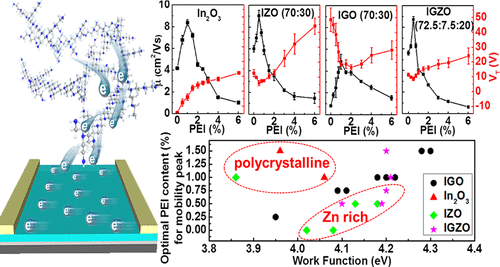当前位置:
X-MOL 学术
›
J. Am. Chem. Soc.
›
论文详情
Our official English website, www.x-mol.net, welcomes your feedback! (Note: you will need to create a separate account there.)
Metal Composition and Polyethylenimine Doping Capacity Effects on Semiconducting Metal Oxide-Polymer Blend Charge Transport
Journal of the American Chemical Society ( IF 15.0 ) Pub Date : 2018-04-04 , DOI: 10.1021/jacs.8b01252 Wei Huang 1, 2 , Peijun Guo 3 , Li Zeng 4 , Ran Li 3 , Binghao Wang 1 , Gang Wang 1 , Xinan Zhang 1 , Robert P. H. Chang 3 , Junsheng Yu 2 , Michael J. Bedzyk 3, 4 , Tobin J. Marks 1 , Antonio Facchetti 1, 5
Journal of the American Chemical Society ( IF 15.0 ) Pub Date : 2018-04-04 , DOI: 10.1021/jacs.8b01252 Wei Huang 1, 2 , Peijun Guo 3 , Li Zeng 4 , Ran Li 3 , Binghao Wang 1 , Gang Wang 1 , Xinan Zhang 1 , Robert P. H. Chang 3 , Junsheng Yu 2 , Michael J. Bedzyk 3, 4 , Tobin J. Marks 1 , Antonio Facchetti 1, 5
Affiliation

|
Charge transport and film microstructure evolution are investigated in a series of polyethylenimine (PEI)-doped (0.0-6.0 wt%) amorphous metal oxide (MO) semiconductor thin film blends. Here, PEI doping generality is broadened from binary In2O3 to ternary (e.g., In+Zn in IZO, In+Ga in IGO) and quaternary (e.g., In+Zn+Ga in IGZO) systems, demonstrating the universality of this approach for polymer electron doping of MO matrices. Systematic comparison of the effects of various metal ions on the electronic transport and film microstructure of these blends are investigated by combined thin-film transistor (TFT) response, AFM, XPS, XRD, X-ray reflectivity, and cross-sectional TEM. Morphological analysis reveals that layered MO film microstructures predominate in PEI-In2O3, but become less distinct in IGO and are not detectable in IZO and IGZO. TFT charge transport measurements indicate a general coincidence of a peak in carrier mobility (μpeak) and overall TFT performance at optimal PEI doping concentrations. Optimal PEI loadings that yield μpeak values depend not only on the MO elemental composition but also, equally important, on the metal atomic ratios. By investigating the relationship between the MO energy levels and PEI doping by UPS, it is concluded that the efficiency of PEI electron-donation is highly dependent on the metal oxide matrix work function in cases where film morphology is optimal, as in the IGO compositions. The results of this investigation demonstrate the broad generality and efficacy of PEI electron doping applied to electronically functional metal oxide systems and that the resulting film microstructure, morphology, and energy level modifications are all vital to understanding charge transport in these amorphous oxide blends.
中文翻译:

金属成分和聚乙烯亚胺掺杂容量对半导体金属氧化物-聚合物混合物电荷传输的影响
在一系列聚乙烯亚胺 (PEI) 掺杂 (0.0-6.0 wt%) 非晶金属氧化物 (MO) 半导体薄膜混合物中研究了电荷传输和薄膜微结构演变。在这里,PEI 掺杂的普遍性从二元 In2O3 扩展到三元(例如,IZO 中的 In+Zn,IGO 中的 In+Ga)和四元(例如,IGZO 中的 In+Zn+Ga)系统,证明了这种方法对聚合物的普遍性MO 矩阵的电子掺杂。通过组合薄膜晶体管 (TFT) 响应、AFM、XPS、XRD、X 射线反射率和横截面 TEM,系统比较了各种金属离子对这些共混物的电子传输和薄膜微观结构的影响。形态学分析表明,层状 MO 膜微结构在 PEI-In2O3 中占主导地位,但在 IGO 中变得不那么明显,并且在 IZO 和 IGZO 中检测不到。TFT 电荷传输测量表明载流子迁移率峰值 (μpeak) 与最佳 PEI 掺杂浓度下的整体 TFT 性能一般一致。产生 μpeak 值的最佳 PEI 加载量不仅取决于 MO 元素组成,而且同样重要的是取决于金属原子比。通过研究 MO 能级与 UPS 掺杂的 PEI 之间的关系,得出的结论是,在膜形态最佳的情况下,如 IGO 组合物,PEI 电子供体的效率高度依赖于金属氧化物基质功函数。这项研究的结果证明了 PEI 电子掺杂应用于电子功能金属氧化物系统的广泛通用性和有效性,以及由此产生的薄膜微观结构、形态、
更新日期:2018-04-04
中文翻译:

金属成分和聚乙烯亚胺掺杂容量对半导体金属氧化物-聚合物混合物电荷传输的影响
在一系列聚乙烯亚胺 (PEI) 掺杂 (0.0-6.0 wt%) 非晶金属氧化物 (MO) 半导体薄膜混合物中研究了电荷传输和薄膜微结构演变。在这里,PEI 掺杂的普遍性从二元 In2O3 扩展到三元(例如,IZO 中的 In+Zn,IGO 中的 In+Ga)和四元(例如,IGZO 中的 In+Zn+Ga)系统,证明了这种方法对聚合物的普遍性MO 矩阵的电子掺杂。通过组合薄膜晶体管 (TFT) 响应、AFM、XPS、XRD、X 射线反射率和横截面 TEM,系统比较了各种金属离子对这些共混物的电子传输和薄膜微观结构的影响。形态学分析表明,层状 MO 膜微结构在 PEI-In2O3 中占主导地位,但在 IGO 中变得不那么明显,并且在 IZO 和 IGZO 中检测不到。TFT 电荷传输测量表明载流子迁移率峰值 (μpeak) 与最佳 PEI 掺杂浓度下的整体 TFT 性能一般一致。产生 μpeak 值的最佳 PEI 加载量不仅取决于 MO 元素组成,而且同样重要的是取决于金属原子比。通过研究 MO 能级与 UPS 掺杂的 PEI 之间的关系,得出的结论是,在膜形态最佳的情况下,如 IGO 组合物,PEI 电子供体的效率高度依赖于金属氧化物基质功函数。这项研究的结果证明了 PEI 电子掺杂应用于电子功能金属氧化物系统的广泛通用性和有效性,以及由此产生的薄膜微观结构、形态、



























 京公网安备 11010802027423号
京公网安备 11010802027423号